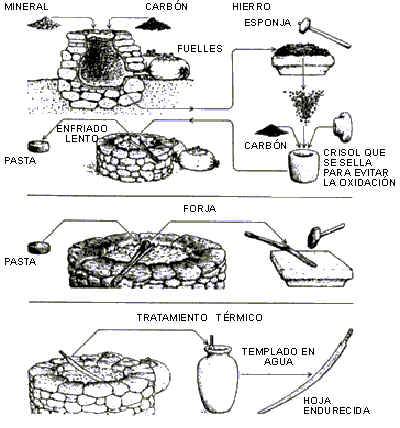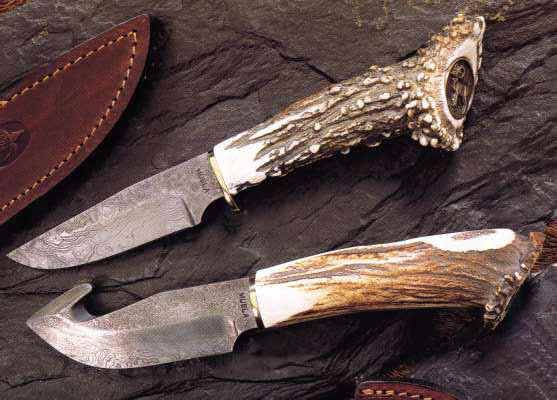The world of the smelting began to walk and the man devised molds with which to obtain reproductions of the objects that created. The technique of the smelting was advancing as the talent of the smelter devised new procedures to fuse new objects. To thus the turn arrived them at the knives and swords. Arrived east moment, the smelter had stone molds that the same stature, using itself chisels of other harder stones or fused escoplos of sand bronze previously. Already having smelter of bivalbos stone molds and cooked mud crucibles, the "sword one is born of bronze" in its primitive state, thought by him man like non throw able weapon to fight to very short distance: hand-to-hand. These new swords, are rather short, but later, animated already by the dominion of the matter, the smelters dared to increase the length of the leaves of the swords since the espadero tried prolonging the leaf to distance to the adversary.
The man is handling the office and will be discovering, by means of his work, as much the ideal mixtures for the hardness of the leaf of the sword, like the necessary refuted ones in cold to the edges. The bronze smelting of the whole sword will not be made until last centuries. In their beginnings the leaf and the grip of the sword were fused separately to later unite them by nailed riveting or.
The man is handling the office and will be discovering, by means of his work, as much the ideal mixtures for the hardness of the leaf of the sword, like the necessary refuted ones in cold to the edges. The bronze smelting of the whole sword will not be made until last centuries. In their beginnings the leaf and the grip of the sword were fused separately to later unite them by nailed riveting or.

The oldest description of the swords of Damascus dates from year 540 of ours was, but they can long before have been in use, even at the time of Alexander Magno (ca. 323 To C.). The own steel was done in India, in where wootz was denominated. But it was at time of Domiciano when the steel settled in Damascus (capital of Syria), along with a great number of important espaderos that helped to make of the city an important commercial center. That importance of Damascus caused the creation of a procedure of hard and non fragile steel obtaining that tube its origin in Northern India. Which, reached a great importance and recognition in Damascus arriving to name "damascene steel" or "damasked steel", giving these names to the steel treated similarly to this.
Always there were relation between the toledanos espaderos and those of Damascus. But they were moments of necessity to find an improvement of the quality of the swords, so the toledanos espaderos investigated the composition of the steel Damascene, its surfaces grained with precious irisaciones formed by all the gamma of grays and its faculty of fort without becoming broken nor bending. These qualities of the steel would serve as departure point for the forge of the leaf of the toledana sword with "alma de hierro".
When investigating the qualities of the steel Damascene discovered that the grained adornment of the leaves of the swords was the base of its quality, everything had to the mixture, during the forge, of carbon diamond materials different, generally the iron and the steel. But the matters that composed the leaves of the swords had diverse materials; carbon, silicon, sulfur, phosphorus, magnesium, nickel and chromium. But the important thing for the toledanos forjadores was the quality of the hardness and flexibility of the swords, and that obtained with the union by the forge of the iron and the steel.
The steel Damascene obtained by the union of pieces of iron and steel, by means of the called process of weld "a calda". The way commonest of that union of the steel Damascene was to enroscar diverse rods of steel and iron, forging that handful and uniting the rods in a single piece obtaining a solid bar, of which, later, they would forge the dagger or sword blade.
Always there were relation between the toledanos espaderos and those of Damascus. But they were moments of necessity to find an improvement of the quality of the swords, so the toledanos espaderos investigated the composition of the steel Damascene, its surfaces grained with precious irisaciones formed by all the gamma of grays and its faculty of fort without becoming broken nor bending. These qualities of the steel would serve as departure point for the forge of the leaf of the toledana sword with "alma de hierro".
When investigating the qualities of the steel Damascene discovered that the grained adornment of the leaves of the swords was the base of its quality, everything had to the mixture, during the forge, of carbon diamond materials different, generally the iron and the steel. But the matters that composed the leaves of the swords had diverse materials; carbon, silicon, sulfur, phosphorus, magnesium, nickel and chromium. But the important thing for the toledanos forjadores was the quality of the hardness and flexibility of the swords, and that obtained with the union by the forge of the iron and the steel.
The steel Damascene obtained by the union of pieces of iron and steel, by means of the called process of weld "a calda". The way commonest of that union of the steel Damascene was to enroscar diverse rods of steel and iron, forging that handful and uniting the rods in a single piece obtaining a solid bar, of which, later, they would forge the dagger or sword blade.

The mixture of the steel Damascene to give to strength and flexibility to the weapon already was obtained, but also it had some failure, the possibility that some point of its edges was made up of an iron vein. The ability of the toledanos espaderos improved the invention, devised the sword with "alma de hierro", that it left from the same principle to mix iron and steel, but guaranteeing that the edges of their swords always were covered with steel, although the final result did not have those irisaciones in the leaves.
"Alma de hierro" it consisted of a hard steel sword that hid in its interior a sweet iron lamina, preventing that the leaf became broken no matter how much this one struck or doubled. Because the iron and the steel have to a certain temperature a high degree of weld ability, being the propitious point to execute the unions in the called swords of iron soul.
Let us remember that to the Tajo river almost miraculous properties have been attributed to him that give quality to the toledanas swords. It has been spoken of the magnificence of his waters to warm up much, not yet verified. But it has been spoken little of sands of the Edge, and is in them where one thinks that it was the key of that quality. Of this form the best swords of the world dreamed up and warmed up in Toledo during centuries XVI and XVII.
"Alma de hierro" it consisted of a hard steel sword that hid in its interior a sweet iron lamina, preventing that the leaf became broken no matter how much this one struck or doubled. Because the iron and the steel have to a certain temperature a high degree of weld ability, being the propitious point to execute the unions in the called swords of iron soul.
Let us remember that to the Tajo river almost miraculous properties have been attributed to him that give quality to the toledanas swords. It has been spoken of the magnificence of his waters to warm up much, not yet verified. But it has been spoken little of sands of the Edge, and is in them where one thinks that it was the key of that quality. Of this form the best swords of the world dreamed up and warmed up in Toledo during centuries XVI and XVII.

These toledanas swords were exported to all parts. But what greater interest woke up in that international market of horsemen of layer and sword, it was a good toledana leaf that it took well visible his mark. Therefore the number of European espaderos was great that acquired the leaves of Toledo to adapt them to their trimmings, or that sent his here cazoletas and sparrow hawks so that they were mounted with toledanas leaves. In Toledo the espaderos were many that often had striker pin with that they marked his production responding with it of the quality of his work, and, besides to punch with his mark, they recorded his name in the leaves sanctioning with it to the sword and its possessor.
No comments:
Post a Comment